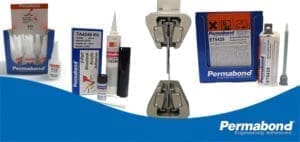
We are often asked “What is the strongest glue for metal to metal?” For most applications the strongest metal glue is one part metal bonding epoxy also known as heat activated epoxy (heat curing epoxy). Typical bond strengths of three adhesive types are compared below.
Strongest metal glue?
For the highest bond strength, one part epoxies are the best metal bonding epoxy.
With the onset of all of the new plastics and composites, metals continue to be desirable in applications that require a heat resistance. High temperature epoxy adhesives are usually one part epoxy. Specialty two part epoxy adhesives that have a secondary heat curing phase achieve higher temperature resistance than conventional two part epoxy.
One part epoxy adhesives are not only the strongest glue for metal to metal, they also provide the highest heat resistance. Standard and high heat resistant adhesive types are listed below.
In addition to strength and heat resistance, when selecting a one part metal bonding epoxy adhesive, it is important to determine if and how much you’d like the adhesive to flow prior to curing. As the temperature in the heat curing oven raises, some epoxies can flow or sag.
Three primary categories of one part epoxy adhesives are:
So far we’ve determined that one part epoxy is the strongest glue for metal to metal and it is a high heat resistant adhesive, the third factor in selecting metal glue is chemical resistance, and once again, one part epoxy lead the pack!
Below is a comparison of the same adhesive types for non-polar solvents. For example, non-polar solvents include: motor oil, toluene, gasoline.
Examples of polar solvents include: water, ethylene glycol, isopropyl alcohol, and acetone. All three types of adhesives listed above have very good resistance to polar solvents.
In addition to strength, chemical resistance, and temperature resistance, one part epoxy adhesives also provide the following benefits.
For many applications this process is ideal, for other applications it can be cumbersome.
Although heat cure is a fairly quick and easy process, dispensing two component epoxy adhesives via static mix tips and just allowing them to cure at room temperature is preferable by many. In other applications the instant cure of cyanoacrylates or cure on demand of UV curable make processing more efficient. For many metal to metal or metal to magnet applications no mix structural acrylics in which an activator is applied to one surface and resin to the other – are ideal as the handling time is less than 5 minutes.
For further help, please contact Permabond.